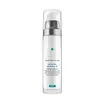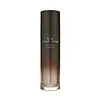What's inside
What's inside
 Key Ingredients
Key Ingredients

 Benefits
Benefits

 Concerns
Concerns

 Ingredients Side-by-side
Ingredients Side-by-side

Water
Skin ConditioningGlycerin
HumectantDimethicone
EmollientNiacinamide
SmoothingPropanediol
SolventDimethicone/PEG-10/15 Crosspolymer
Methylsilanol/Silicate Crosspolymer
Skin ConditioningSodium Chloride
MaskingPolymethylsilsesquioxane
Phenoxyethanol
PreservativeMicrocrystalline Cellulose
AbsorbentCI 77163
Cosmetic ColorantChlorphenesin
AntimicrobialCaprylyl Glycol
EmollientSodium Citrate
BufferingEthylhexyl Hydroxystearate
EmollientPEG-10 Dimethicone
Skin ConditioningDisodium EDTA
Cellulose Gum
Emulsion StabilisingLaminaria Digitata Extract
Skin ProtectingAdenosine
Skin ConditioningCitrus Aurantium Amara Flower Oil
MaskingMelaleuca Viridiflora Leaf Oil
Skin ConditioningTetradecyl Aminobutyroylvalylaminobutyric Urea Trifluoroacetate
Skin ConditioningLinalool
PerfumingCymbopogon Flexuosus Oil
MaskingCitral
PerfumingLimonene
PerfumingPelargonium Graveolens Flower Oil
MaskingWater, Glycerin, Dimethicone, Niacinamide, Propanediol, Dimethicone/PEG-10/15 Crosspolymer, Methylsilanol/Silicate Crosspolymer, Sodium Chloride, Polymethylsilsesquioxane, Phenoxyethanol, Microcrystalline Cellulose, CI 77163, Chlorphenesin, Caprylyl Glycol, Sodium Citrate, Ethylhexyl Hydroxystearate, PEG-10 Dimethicone, Disodium EDTA, Cellulose Gum, Laminaria Digitata Extract, Adenosine, Citrus Aurantium Amara Flower Oil, Melaleuca Viridiflora Leaf Oil, Tetradecyl Aminobutyroylvalylaminobutyric Urea Trifluoroacetate, Linalool, Cymbopogon Flexuosus Oil, Citral, Limonene, Pelargonium Graveolens Flower Oil
Water
Skin ConditioningDipropylene Glycol
HumectantGanoderma Lucidum Extract 3.51%
Skin ProtectingPhellinus Linteus Extract 3.51%
Skin ConditioningSparassis Crispa Extract 3.51%
Emulsion StabilisingTrametes Versicolor Extract 3.51%
Tremella Fuciformis Extract 3.51%
HumectantGlycerin
HumectantButylene Glycol
HumectantSaccharomyces Ferment Filtrate 2.48%
HumectantEthylhexyl Stearate
EmollientIsopentyldiol
HumectantNiacinamide
Smoothing1,2-Hexanediol
Skin ConditioningCetyl Ethylhexanoate
EmollientPropylene Glycol Dibenzoate
Skin ConditioningCetearyl Olivate
Triethylhexanoin
MaskingTrilaureth-4 Phosphate
EmulsifyingSorbitan Olivate
EmulsifyingHydroxyethyl Acrylate/Sodium Acryloyldimethyl Taurate Copolymer
Emulsion StabilisingParfum
MaskingTromethamine
BufferingAcrylates/C10-30 Alkyl Acrylate Crosspolymer
Emulsion StabilisingCarbomer
Emulsion StabilisingXanthan Gum
EmulsifyingEthylhexylglycerin
Skin ConditioningAdenosine
Skin ConditioningDextrin
AbsorbentTheobroma Cacao Extract
Skin ConditioningSorbitan Isostearate
EmulsifyingDisodium EDTA
Beta-Glucan
Skin ConditioningMannitol
HumectantCaprylyl Glycol
EmollientHydrogenated Lecithin
EmulsifyingCetearyl Alcohol
EmollientStearic Acid
CleansingAcetyl Hexapeptide-8
HumectantErgothioneine
AntioxidantCeramide NP
Skin ConditioningCeramide Ns
Skin ConditioningCholesterol
EmollientPhytosphingosine
Skin ConditioningCeramide AP
Skin ConditioningCeramide As
Skin ConditioningCeramide EOP
Skin ConditioningWater, Dipropylene Glycol, Ganoderma Lucidum Extract 3.51%, Phellinus Linteus Extract 3.51%, Sparassis Crispa Extract 3.51%, Trametes Versicolor Extract 3.51%, Tremella Fuciformis Extract 3.51%, Glycerin, Butylene Glycol, Saccharomyces Ferment Filtrate 2.48%, Ethylhexyl Stearate, Isopentyldiol, Niacinamide, 1,2-Hexanediol, Cetyl Ethylhexanoate, Propylene Glycol Dibenzoate, Cetearyl Olivate, Triethylhexanoin, Trilaureth-4 Phosphate, Sorbitan Olivate, Hydroxyethyl Acrylate/Sodium Acryloyldimethyl Taurate Copolymer, Parfum, Tromethamine, Acrylates/C10-30 Alkyl Acrylate Crosspolymer, Carbomer, Xanthan Gum, Ethylhexylglycerin, Adenosine, Dextrin, Theobroma Cacao Extract, Sorbitan Isostearate, Disodium EDTA, Beta-Glucan, Mannitol, Caprylyl Glycol, Hydrogenated Lecithin, Cetearyl Alcohol, Stearic Acid, Acetyl Hexapeptide-8, Ergothioneine, Ceramide NP, Ceramide Ns, Cholesterol, Phytosphingosine, Ceramide AP, Ceramide As, Ceramide EOP
 Reviews
Reviews

Ingredients Explained
These ingredients are found in both products.
Ingredients higher up in an ingredient list are typically present in a larger amount.
Adenosine is in every living organism. It is one of four components in nucleic acids that helps store our DNA.
Adenosine has many benefits when used. These benefits include hydrating the skin, smoothing skin, and reducing wrinkles. Once applied, adenosine increases collagen production. It also helps with improving firmness and tissue repair.
Studies have found adenosine may also help with wound healing.
In skincare products, Adenosine is usually derived from yeast.
Learn more about AdenosineCaprylyl Glycol is a humectant and emollient, meaning it attracts and preserves moisture.
It is a common ingredient in many products, especially those designed to hydrate skin. The primary benefits are retaining moisture, skin softening, and promoting a healthy skin barrier.
Though Caprylyl Glycol is an alcohol derived from fatty acids, it is not the kind that can dry out skin.
This ingredient is also used as a preservative to extend the life of products. It has slight antimicrobial properties.
Learn more about Caprylyl GlycolDisodium EDTA plays a role in making products more stable by aiding other preservatives.
It is a chelating agent, meaning it neutralizes metal ions that may be found in a product.
Disodium EDTA is a salt of edetic acid and is found to be safe in cosmetic ingredients.
Learn more about Disodium EDTAGlycerin is already naturally found in your skin. It helps moisturize and protect your skin.
A study from 2016 found glycerin to be more effective as a humectant than AHAs and hyaluronic acid.
As a humectant, it helps the skin stay hydrated by pulling moisture to your skin. The low molecular weight of glycerin allows it to pull moisture into the deeper layers of your skin.
Hydrated skin improves your skin barrier; Your skin barrier helps protect against irritants and bacteria.
Glycerin has also been found to have antimicrobial and antiviral properties. Due to these properties, glycerin is often used in wound and burn treatments.
In cosmetics, glycerin is usually derived from plants such as soybean or palm. However, it can also be sourced from animals, such as tallow or animal fat.
This ingredient is organic, colorless, odorless, and non-toxic.
Glycerin is the name for this ingredient in American English. British English uses Glycerol/Glycerine.
Learn more about GlycerinNiacinamide is a multitasking form of vitamin B3 that strengthens the skin barrier, reduces pores and dark spots, regulates oil, and improves signs of aging.
And the best part? It's gentle and well-tolerated by most skin types, including sensitive and reactive skin.
You might have heard of "niacin flush", or the reddening of skin that causes itchiness. Niacinamide has not been found to cause this.
In very rare cases, some individuals may not be able to tolerate niacinamide at all or experience an allergic reaction to it.
If you are experiencing flaking, irritation, and dryness with this ingredient, be sure to double check all your products as this ingredient can be found in all categories of skincare.
When incorporating niacinamide into your routine, look out for concentration amounts. Typically, 5% niacinamide provides benefits such as fading dark spots. However, if you have sensitive skin, it is better to begin with a smaller concentration.
When you apply niacinamide to your skin, your body converts it into nicotinamide adenine dinucleotide (NAD). NAD is an essential coenzyme that is already found in your cells as "fuel" and powers countless biological processes.
In your skin, NAD helps repair cell damage, produce new healthy cells, support collagen production, strengthen the skin barrier, and fight environmental stressors (like UV and pollution).
Our natural NAD levels start to decline with age, leading to slower skin repair, visible aging, and a weaker skin barrier. By providing your skin niacinamide, you're recharging your skin's NAD levels. This leads to stronger, healthier, and younger looking skin.
Another name for vitamin B3 is nicotinamide. This vitamin is water-soluble and our bodies don't store it. We obtain Vitamin B3 from either food or skincare. Meat, fish, wheat, yeast, and leafy greens contain vitamin B3.
The type of niacinamide used in skincare is synthetically created.
Learn more about NiacinamideWater. It's the most common cosmetic ingredient of all. You'll usually see it at the top of ingredient lists, meaning that it makes up the largest part of the product.
So why is it so popular? Water most often acts as a solvent - this means that it helps dissolve other ingredients into the formulation.
You'll also recognize water as that liquid we all need to stay alive. If you see this, drink a glass of water. Stay hydrated!
Learn more about Water